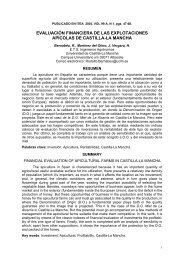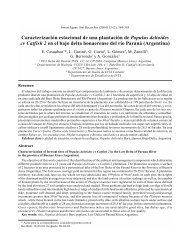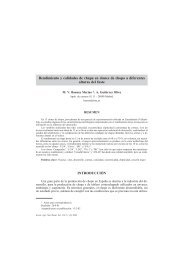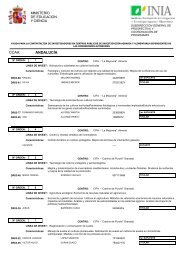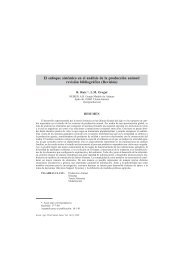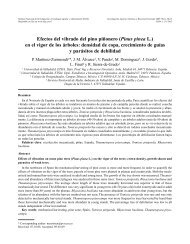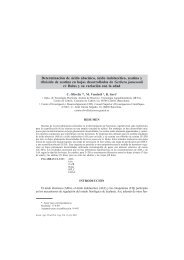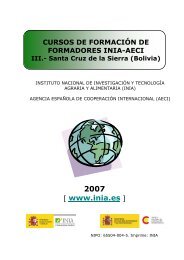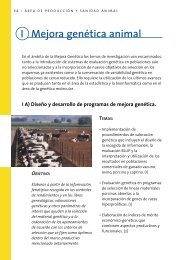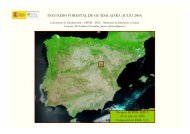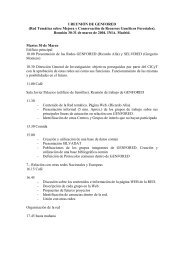Status of medicinal and aromatic plants in - Inia
Status of medicinal and aromatic plants in - Inia
Status of medicinal and aromatic plants in - Inia
Create successful ePaper yourself
Turn your PDF publications into a flip-book with our unique Google optimized e-Paper software.
140<br />
WORKING GROUP ON MEDICINAL AND AROMATIC PLANTS: FIRST MEETING<br />
S<strong>in</strong>ce the establishment <strong>of</strong> the Institute for Medic<strong>in</strong>al Plant Research "Dr Josif Pančić"<br />
(1948), much has been learned about the pharmacological features <strong>of</strong> MAPs. Other<br />
<strong>in</strong>stitutions also deal with evaluation <strong>of</strong> chemical content, active substances <strong>and</strong> qualitative<br />
composition <strong>of</strong> MAP drugs, as well as their <strong>in</strong>fluence on cells <strong>of</strong> bacteria, fungi <strong>and</strong> cancer<br />
(Faculty <strong>of</strong> Pharmacy, Faculty <strong>of</strong> Technology, Faculty <strong>of</strong> Chemistry, Faculty <strong>of</strong> Biology, etc.).<br />
The special challenge for the com<strong>in</strong>g decades, <strong>in</strong> our op<strong>in</strong>ion, is cultivation <strong>and</strong>/or<br />
improvement <strong>of</strong> new technologies for production <strong>of</strong> endangered <strong>medic<strong>in</strong>al</strong> <strong>plants</strong>, because<br />
many <strong>of</strong> them are still not cultivated. Among them, the follow<strong>in</strong>g species could be stressed:<br />
St John's wort, eyebright, yarrow, Lady's mantle, gentian, chicory, uva ursi, digitalis,<br />
agrimony, borage, centaury <strong>and</strong> many others. Production technologies have already been<br />
developed for some endangered or vulnerable <strong>medic<strong>in</strong>al</strong> <strong>plants</strong> <strong>and</strong> therefore it is expected<br />
that their production will <strong>in</strong>crease <strong>in</strong> the future (sage, hyssop, valerian, angelica, lemon<br />
balm, marshmallow, etc.). It is important to emphasize that many species controlled by the<br />
state may be used for cheap <strong>and</strong> very efficient soil conservation, i.e. for prevent<strong>in</strong>g both<br />
erosion <strong>and</strong> leach<strong>in</strong>g <strong>of</strong> hilly-mounta<strong>in</strong>ous soils (e.g. sage, hyssop, lavender, mugwort).<br />
Breed<strong>in</strong>g <strong>and</strong> further selection <strong>of</strong> MAPs <strong>in</strong> Serbia, together with the proper choice <strong>of</strong><br />
habitat for their production, is <strong>of</strong> great importance. There are <strong>in</strong>dications that more than half<br />
<strong>of</strong> all cultivated MAP areas are sown with non-registered seeds, result<strong>in</strong>g <strong>in</strong> low yields <strong>and</strong><br />
uncerta<strong>in</strong> drug quality (Dr Slobodan Drazić, personal communication).<br />
Furthermore, the acquisition <strong>of</strong> both cultivation technologies (where more efforts should<br />
be dedicated to weed <strong>and</strong> pest control) <strong>and</strong> modern raw process<strong>in</strong>g methods is necessary. It<br />
is also important to def<strong>in</strong>e the current capacities for MAP production (habitat properties, soil<br />
characteristics, climate, irrigation possibilities, availability <strong>of</strong> mach<strong>in</strong>ery <strong>and</strong> process<strong>in</strong>g<br />
facilities), to supply proper seed or seedl<strong>in</strong>g material, to cooperate with state <strong>and</strong> private<br />
enterprises <strong>and</strong> scientific <strong>in</strong>stitutions <strong>and</strong> to analyze the whole f<strong>in</strong>ancial framework <strong>and</strong><br />
possible risks.<br />
Application <strong>of</strong> molecular genetics technologies to MAP studies could provide further<br />
possibilities for evaluation <strong>of</strong> suitable genotypes <strong>and</strong> quality evaluation <strong>of</strong> MAP products.<br />
No serious research at the molecular level on MAPs has been conducted <strong>in</strong> F.R.Y. so far.<br />
However, the Department <strong>of</strong> Botany <strong>of</strong> the Faculty <strong>of</strong> Agriculture (University <strong>of</strong> Belgrade) <strong>in</strong><br />
cooperation with the Royal Botanical Gardens <strong>in</strong> Kew (United K<strong>in</strong>gdom) has undertaken a<br />
new <strong>and</strong> promis<strong>in</strong>g project consider<strong>in</strong>g diversity <strong>and</strong> evolution <strong>of</strong> different species <strong>of</strong> the<br />
genus Thymus, mostly endemics <strong>of</strong> southeast Serbia <strong>and</strong> the Balkan Pen<strong>in</strong>sula. This research<br />
will <strong>in</strong>clude determ<strong>in</strong>ation <strong>of</strong> collected plant material accord<strong>in</strong>g to cDNA sequenc<strong>in</strong>g. It is<br />
expected that results will serve for further cultivation <strong>and</strong> selection <strong>of</strong> certa<strong>in</strong> thyme species.<br />
At the beg<strong>in</strong>n<strong>in</strong>g <strong>of</strong> 2002 the M<strong>in</strong>istry <strong>of</strong> Science <strong>and</strong> Technology <strong>of</strong> Serbia approved <strong>and</strong><br />
started f<strong>in</strong>anc<strong>in</strong>g several national scientific projects that encompass all aspects <strong>of</strong> MAPs, both<br />
fundamental <strong>and</strong> applied.<br />
There is <strong>in</strong>deed hope for future opportunities for more <strong>in</strong>tensive collaboration with<br />
neighbour<strong>in</strong>g countries <strong>and</strong> all other EU countries through common participation <strong>in</strong><br />
<strong>in</strong>ternational projects <strong>in</strong>volv<strong>in</strong>g multidiscipl<strong>in</strong>ary research on MAPs, <strong>in</strong>clud<strong>in</strong>g the<br />
development <strong>of</strong> a common database.<br />
References<br />
Adamović, D. 2000. The most important results on selection <strong>of</strong> <strong>medic<strong>in</strong>al</strong> <strong>and</strong> <strong>aromatic</strong> <strong>plants</strong>. Pp. 241-<br />
251 <strong>in</strong> Proceed<strong>in</strong>gs <strong>of</strong> the First Conference on Medic<strong>in</strong>al <strong>and</strong> Aromatic Plants <strong>of</strong> Southeast<br />
European Countries, 29 May-3 June 2000, Ar<strong>and</strong>jelovac, Yugoslavia. Institute for Medic<strong>in</strong>al Plant<br />
Research “Dr Josif Pančić” <strong>and</strong> Federal Institute for Plant <strong>and</strong> Animal Genetic Resources, Belgrade.




